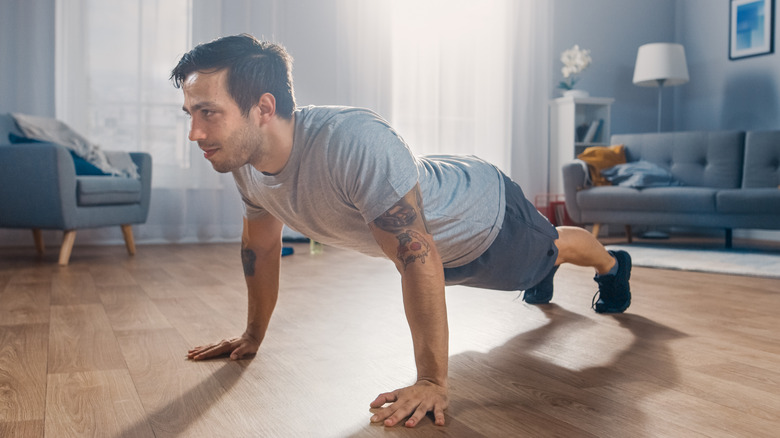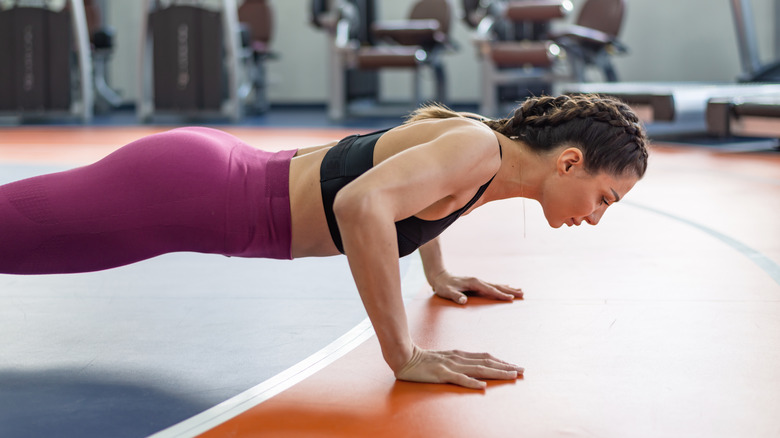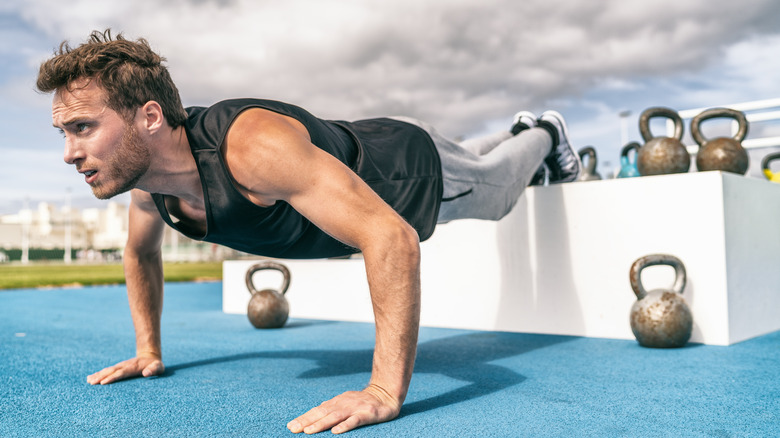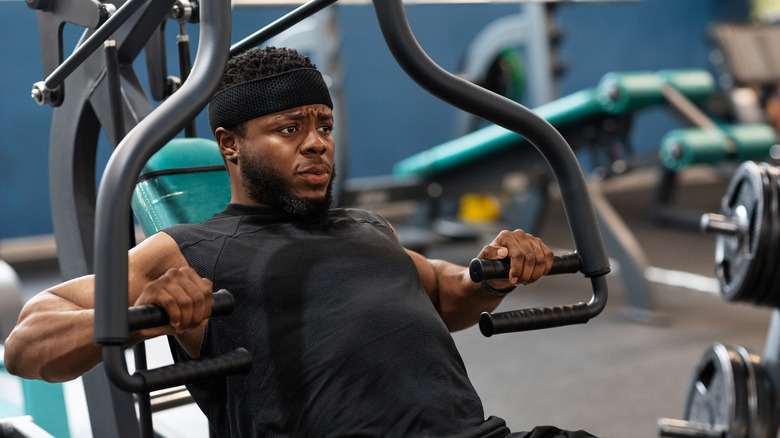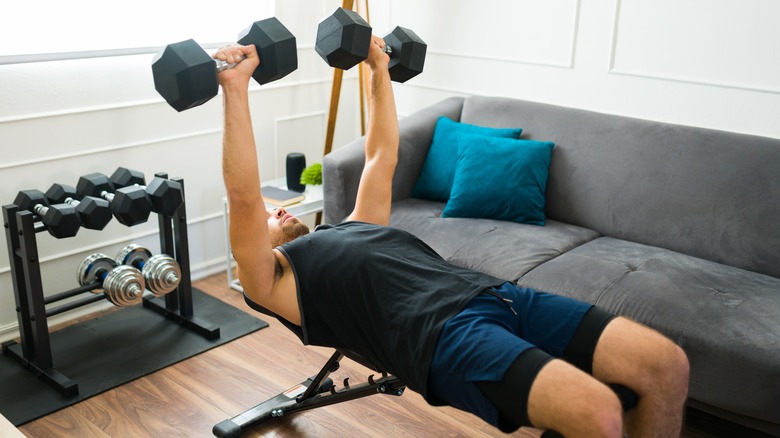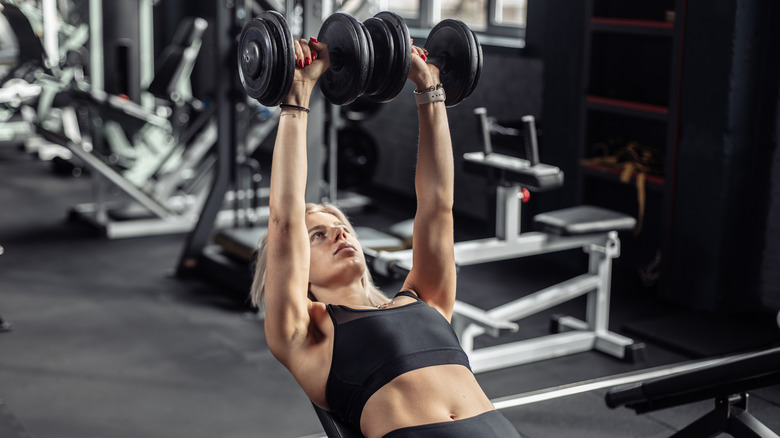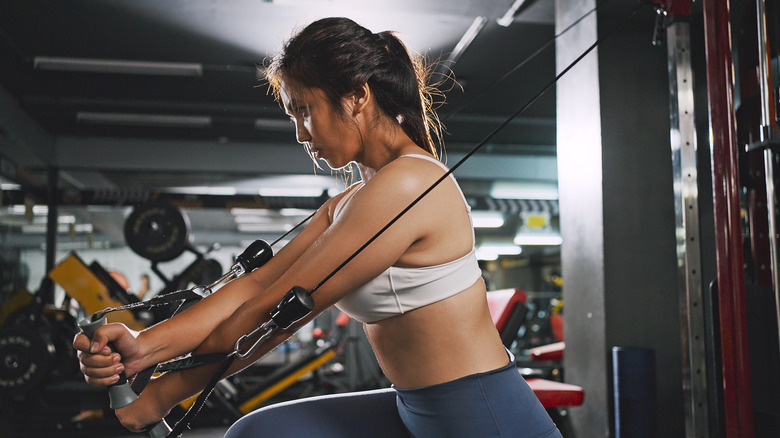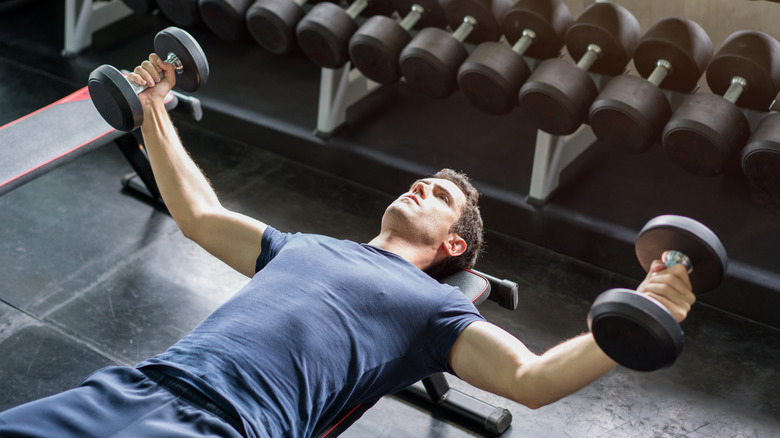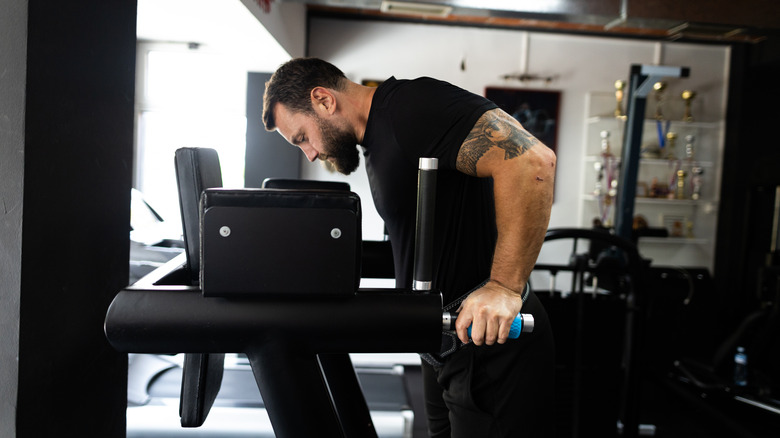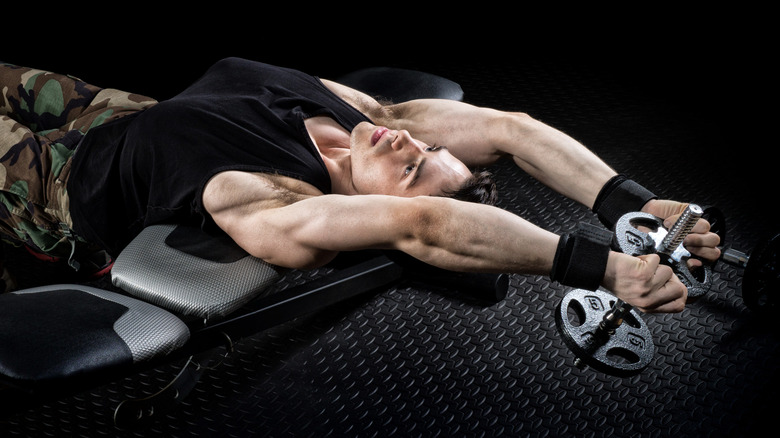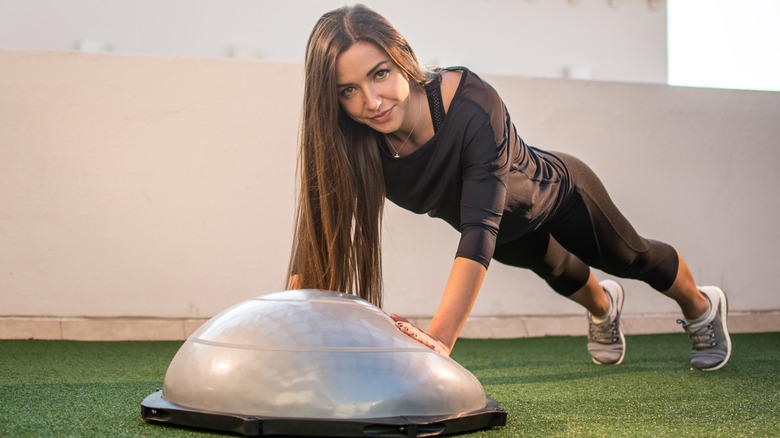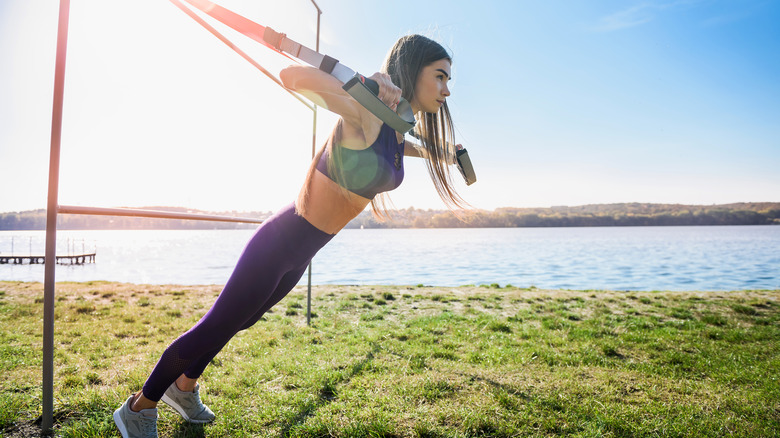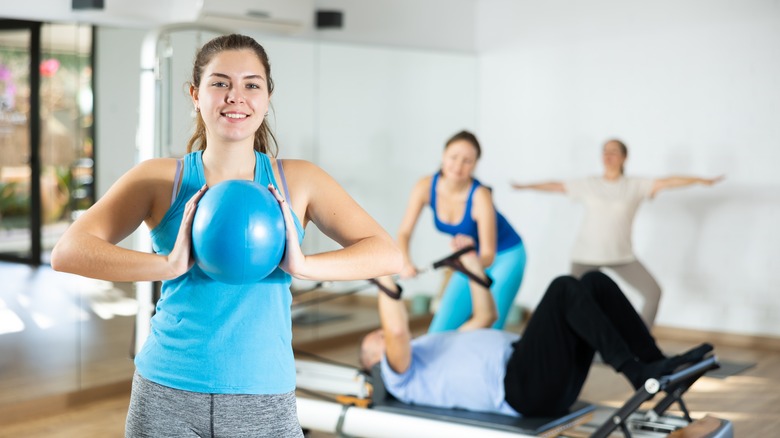Exercises You Should Do To Strengthen Your Chest
Strong, chiseled chest muscles are more than just aesthetically pleasing. They're important for everyday activities, too. The chest muscles, called the pectorals, or "pecs" for short, are the main "push" muscles of the body. They help you push a shopping cart, push a heavy door open, or push a lawnmower. They also contribute to good posture when balanced with strong upper back muscles, and can improve the ease of respiration. For women, building chest muscle can give the breasts a little natural lift.
When you're trying to strengthen your chest muscles, there's no need to get fancy. The pushup is a standby exercise that requires no equipment and no gym membership — and there are countless ways to modify pushups to make them easier or more challenging. There are many other effective chest exercises to work into your routine that can offer variety and work the muscles in different ways. Here are a few to choose from to get you started.
Traditional pushups
Pushups are the go-to chest exercise that you can do anywhere. They're also very easy to modify for both beginner and advanced strength levels. Not only do they target the pectoral muscles, but they also strengthen the triceps, shoulders, back, and abdominals. Having proper form is important to getting the most out of the exercise and not getting injured.
To do a traditional pushup, start on your hands and knees. Align your shoulders over your wrists and keep them that way throughout the exercise. Step your feet back into a plank position. Keep your body in one straight line from your heels to your head. Keep your core muscles contracted to stabilize your back. Begin to bend your elbows as you lower your body towards the floor in one straight line. Don't allow your hips to sag or pike up. Lower down until your chest touches the floor, then begin to reverse the move, pressing yourself up to your starting position. Continuing to engage your core muscles on the upward movement will make it easier.
If you find that you are not yet strong enough for a full pushup, you can do a modified pushup by keeping your knees on the floor throughout the exercise. You can also do a pushup with your hands on a bench or the edge of a sturdy table. You can even do pushups against a wall by stepping your feet back. The higher your hands are elevated, the easier the exercise will be.
Advanced pushup variations
Once you've got the basic pushup technique down and you can do a set of 10 or 12 without breaking form, you are ready for more advanced pushup variations. Orienting your body in different ways during the exercise can slightly change the stress on certain muscles. They'll all still target the chest, but one variation might work the inner or outer chest more than another.
Elevating your feet will make pushups more challenging. You can use a step, a weight bench, or another sturdy object. The higher the feet are, the more difficult it will be. Changing your hand width also makes it harder. You can take a narrow stance, moving your hands closer together beneath your chest. This will target your triceps more. You can also move your hands farther apart for a greater challenge. Next, try staggering your hands — one forward of your shoulders and one back.
Plyometric pushups involve lifting your hands off the ground in an explosive movement. This develops power in your upper body and chest. To do it, start with the downward phase of a regular pushup. On the upward phase, press powerfully so that you can get the momentum to lift your hands off the ground at the top of the move. Quickly clap your hands together, then land with your hands underneath your shoulders and go into your next pushup.
With all of these variations, be sure to maintain proper form with your back straight and core engaged.
Machine bench press
Almost every gym has a chest press machine. Using weight machines has both plusses and drawbacks. One of the upsides is that they're easy to use if you're just getting started. If you're more advanced and you're lifting heavy weight, you can go heavy on a machine without needing a spotter.
Machines will vary slightly in their operation, but they are generally alike. Sit down in the seat facing out. Adjust the seat so that your feet are flat on the floor and the handles are around mid-chest height. Next, adjust the weight stack according to your needs. Grasp the handles with an overhand grip and lift your elbows up and out to the side. Keep your lower back pressed against the back of the seat throughout the exercise. Contract your core muscles and press the handles away from you until your arms are straight, then slowly bend them and come back to the starting position.
When you're just starting out, finding the right weight might take some trial and error. Start with a lighter weight than you think you might need. Do a set of 12 reps and see how you feel. If you need more weight, add it in gradual increments. At the right weight, the last rep of each set should feel very challenging but not impossible.
Dumbbell bench press
Free weights differ from machines in that they offer less support for the body. As a result, your body has to do a bit more work to stay stable. Small stabilizer muscles throughout your arms and chest are activated, and your core has to do more work. This is good for developing more comprehensive strength, but you typically will not be able to lift as much as you can with a machine, at least in the beginning.
Choose your weight and sit down on a weight bench. Slowly lower your back to the bench and bring the dumbbells to your shoulders with your elbows wide. Press your lower back into the bench and keep contact throughout the lift. Contract your core muscles. Start to press the weights above your chest and straighten your arms. The weights should stay at shoulder width or slightly narrower. When your arms are straight, slowly reverse the move, bringing the weights back to the starting position.
You can also do a bench press with a barbell, although it's a good idea for beginners to get used to dumbbells before using a barbell. Whenever you are lifting heavy weights with dumbbells or a barbell, you should be sure to have a spotter to reduce the risk of injury.
Incline/decline free weight bench press
Just like with the pushup variations, changing the positioning of your body during a bench press will slightly change how the exercise targets your muscles. The incline bench press puts a bit more emphasis on the upper pecs and the shoulder muscles.
To get started, you'll need an incline bench. This is typically an adjustable weight bench that lies flat and inclines. Sit down in the seat with your back flat against the back rest. Do not allow your lower back to arch during the movement. Bring the weights up to mid-chest height, elbows bent out to the sides. Contract your core muscles and press the weights away from you overhead. When your arms are fully extended, reverse the movement, bending your elbows and slowly bringing the weights back down to chest level.
A more advanced variation is the decline bench press. This elevates your legs above your chest and changes the angle to hit your lower pecs harder. Adjust the bench so it is declined 15 to 30 degrees. Position yourself on the bench, holding your weights. If you are lifting heavy weights, you may need a barbell rack or someone to hand them to you. Press your back against the bench, contract your core, and press up to straight arms. Then, slowly lower down to your starting position.
Cable crossovers
So far, we've only discussed compound exercises in this list — exercises that work more than one muscle group at a time. Cable crossovers are an isolation exercise, meaning they only target the chest. Many bodybuilders include this exercise in their program because it helps add definition.
Start by setting the weights in your cable machine and position the handles at the highest setting. Grab the handles, move to the center, and open your arms out to either side. Take a step or two forward so that you feel a stretch across your chest. This is a good starting point. Many people like to take a split stance for this exercise, with one foot forward and one foot back, because it provides added stability. Keep your arms rigid with a slight bend in your elbow. Contract your core muscles as you start to draw your hands towards each other. Rather than meeting in the middle, allow one hand to pass over the other, so your forearms are crossed. Then, reverse the move, returning to your starting position with control. Next rep, cross the other hand on top.
You can play with the positioning of the handles to change the exercise. Putting the handles at the lowest setting will turn the move into a low pulley cable crossover. This targets the upper chest in a similar way as the incline bench press.
Dumbbell chest flys
Dumbbell chest flys are a similar version of cable crossovers, except performed horizontally. When selecting weights for this move, you'll want to go significantly lower than for a bench press. Start light and increase from there.
Lie back on the bench and bring your arms up over your chest with your elbows lightly bent and your palms facing in toward each other. Press your back against the bench and contract your core muscles. Slowly begin to open your arms out to the side. Keep a slight bend in your elbows and lower the weights down until you feel a stretch across your chest. Keep the contraction in your chest muscles and start to bring your arms back up and together at the starting position.
You can change the target to the upper or lower chest muscles by doing the dumbbell fly on an incline or decline bench. If you favor machines, most gyms will have a chest fly machine.
Chest dips
Chest dips are an intermediate to advanced exercise requiring you to have enough strength to lift and lower your bodyweight with just your arms. The exercise targets the chest muscles, as well as the shoulders, triceps, and abs. Chest dips target the lower pecs in a way similar to the decline bench press. To do them, you'll need a specific piece of equipment called a dip machine. Parallel bars can also be used.
Step up into the dip station and grasp the bars. Lift your feet off the step and let them hang straight down. Contract your core and glute muscles. Start to bend your elbows to lower yourself in a slow and controlled motion until your forearms are close to parallel with the floor. Then press through the hands to lift the body back up to the starting position.
You can change the target of the exercise with your body positioning. Leaning forward and flaring the elbows out will put more emphasis on the chest, while staying more vertical and keeping the elbows tucked in will place more stress on the triceps.
Dumbbell pullovers
The dumbbell pullover does double duty as an effective exercise to strengthen the back and chest muscles. The primary muscle group targeted is the pecs, and the lats are secondary. Other muscles worked include the deltoids, triceps, and rhomboids.
You'll need a flat weight bench and an appropriately sized dumbbell to do the exercise. Lie back on the bench perpendicularly, with the bench supporting your upper back. Bend your knees to 90 degrees and keep your feet flat on the floor. Grasp one end of the dumbbell with both hands and hold it above your chest with a slight bend in your elbows. Slowly lower the dumbbell over your head until your upper arms are in line with your torso. Contract your chest muscles and pull the dumbbell back up to the starting point.
It's important to take precautions during this move so that you don't injure your shoulders. Start out with a light weight and don't overextend your arms. If you can't get the weight all the way behind you, just lower your arms until you feel a comfortable stretch across your chest and underarms. If you are lifting a heavy weight, it is safest to have someone hand the weight to you when you are already in position and act as a spotter.
Stability ball pushup
Stability balls are any of a variety of inflated spheres or domes. Although they're called stability balls, the benefit is that they create a more unstable surface that makes exercises more challenging. The unstable surface causes your core muscles and stabilizer muscles throughout your body to have to work harder to keep you balanced.
Doing pushups on a stability ball is an intermediate to advanced move. The easiest ball for this exercise is a Bosu ball, or half dome with a flat surface. Place your hands shoulder-width apart on the ball and, keeping your core muscles tight, lower your chest to the ball, then push back up. A large stability ball will be less stable but still relatively easy, since your upper body is elevated higher off the ground.
More challenging variations include the decline pushup, with your feet resting on the ball and your hands on the floor or on another stability ball. You can also choose a small stability ball to do close-grip pushups that emphasize the triceps, or you can do the exercise with one hand on a small stability ball and one hand on the ground. Plyometric pushups on a half dome, where you explode off the ball on the upward movement and clap your hands beneath your chest, are also an option.
Suspension trainer pushup and fly
A suspension trainer consists of one long strap that is anchored to the ceiling in the middle. Each end of the strap has a handle. You can perform a multitude of exercises for the entire body with a suspension trainer. The benefit of this equipment is that it provides an unstable surface to challenge the stabilizer muscles. It's also portable and inexpensive compared to a set of weights.
To do a pushup, adjust the height of the handles to anywhere between chest and shin height. The lower the strap, the more challenging it will be. Hold either handle with an overhand grip and walk your feet out until you are in a plank position. Keep your core engaged and slowly start to lean your body forward as you bend your elbows out to either side. Stop when your chest is in line with your hands, then push back to the starting position.
To do a fly, hold the handles and walk your feet back. Position your arms straight out in front of you with a slight bend in the elbows. Keep your core muscles tight as you slowly open your arms out to the sides until they are in line with your chest. Then, bring them back together to the starting position. For this exercise, the lower the handles are and the farther you step your feet back, the harder the exercise will be.
Stability ball squeeze
The stability ball squeeze is an isometric exercise, which involves muscle engagement without actually moving the muscles. It's a static contraction, similar to the plank exercise. Doing isometric exercises as part of your chest workout can help you improve muscle strength and growth. It also works small stabilizer muscles throughout the upper body.
To do this exercise, take a small stability ball and hold it between your hands in front of your chest. Lift your elbows up and out to the sides. Apply equal pressure to the ball with both hands and squeeze as you contract your chest muscles. Hold the contraction and continue to squeeze for 20 seconds. As you get stronger, you can hold the contraction for longer.
You can also do this exercise with a medium or large stability ball. Simply hold it between your forearms and squeeze as if you're doing a chest fly.

